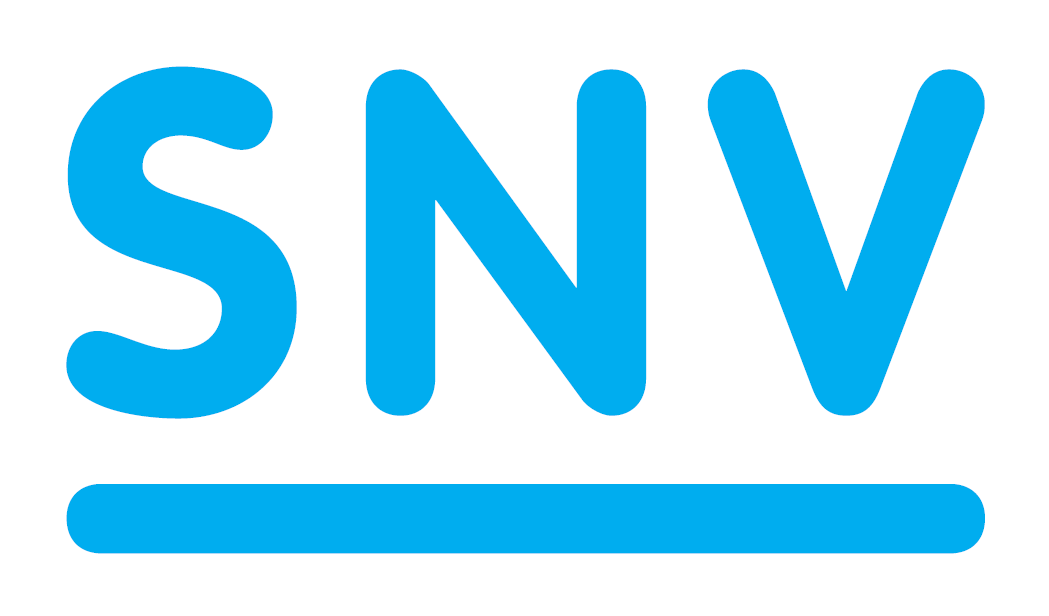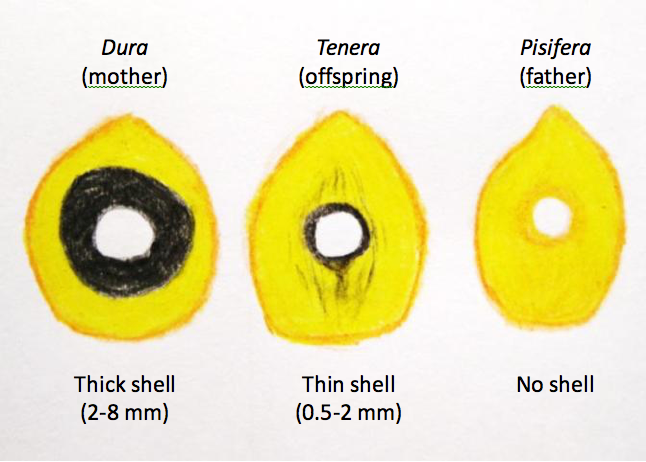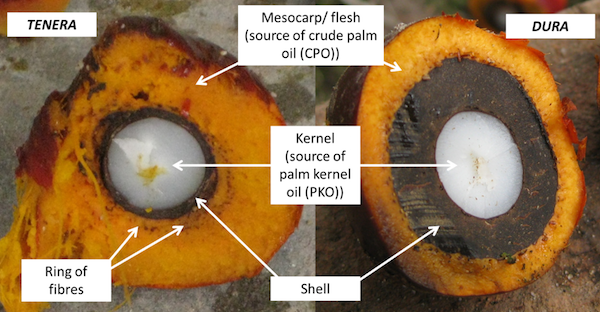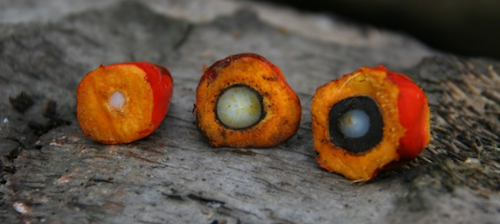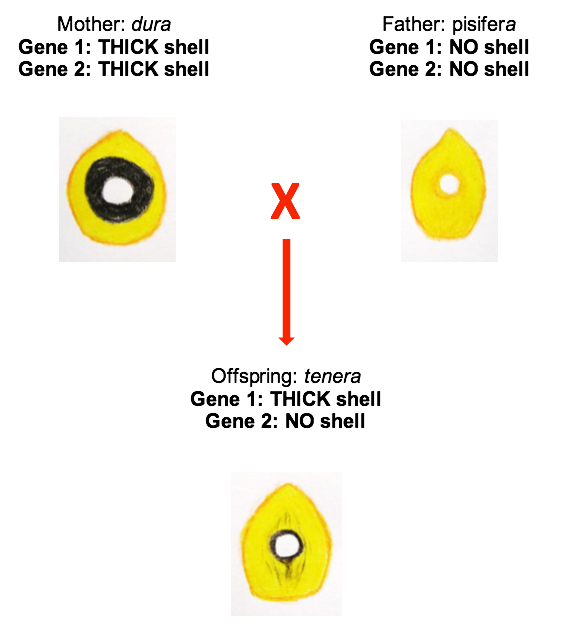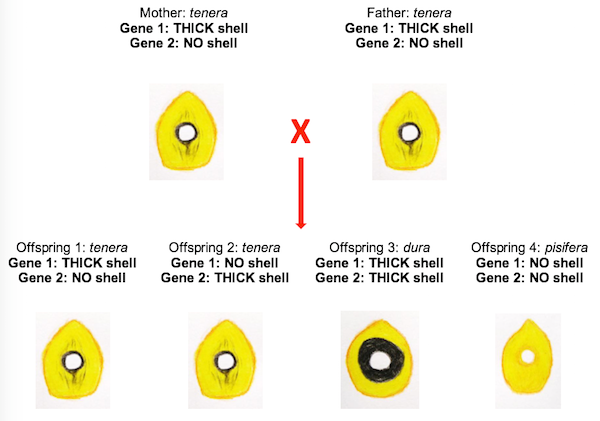Sustainable Oil Palm Farming / Tenera, Dura, and Pisifera
| |
Why are good seeds important?
So make sure you only plant hybrid seeds! |
Download: Module 1: Planting Material
Contents
[hide]Introduction
In oil palm, the best yields are produced by so-called ‘hybrids’. A hybrid is a cross between two different types of parents. Hybrids are produced in specialised breeding companies (see Figure 1). The parents of hybrid oil palms are different because of the thickness of the ‘shell’ of their fruit (see Figure 2).
The shell of an oil palm fruit is the brown/black woody ring between the yellow flesh and the white kernel (see Figure 3). There is no oil in the shell.
Normal palm oil (called crude palm oil or ‘CPO’) is extracted from the yellow flesh, which is also called ‘mesocarp’ (see Figure 3). Oil can also be extracted from the white kernel, and this oil is called ‘palm kernel oil’ or ‘PKO’. However, this is a special oil and normal palm oil factories are not interested in it.
The mother palm of a hybrid is called dura. Dura fruits have a thick shell (see Figure 2). The father palm of a hybrid is called pisifera. Pisifera fruits have no shell at all (see Figure 2).
The cross between dura and pisifera palms is a hybrid called tenera (see Figure 2). Hybrid tenera fruits have a thin shell and the palms produce up to 30 percent more oil than their parents!
Example: Oil production from plantations with tenera, dura and pisifera
In the table below, an example is given for a plantation with good quality hybrid planting materials (Plantation 1) and two plantations with non-hybrid materials (Plantations 2 and 3). This example clearly shows why mills prefer tenera bunches.
Table 1: Oil production in plantations with three types of planting materials
| Plantation 1 | Plantation 2 | Plantation 3 | |
|---|---|---|---|
| Planting material: | 100% tenera | 50% tenera 25% dura |
100% dura |
| Situation: | Good quality certified seeds | Seeds taken and planted from the plantation | Only dura seeds planted |
| FFB yield (t/ha) | 24.0 | 18.0 | 24.0 |
| Oil from tenera (23%) | 5.5 | 2.8 | 0.0 |
| Oil from dura (16%) | 0.0 | 1.0 | 3.8 |
| Oil from pisifera (sterile) | 0.0 | 0.0 | 0.0 |
| TOTAL oil yield (t/ha) | 5.5 | 3.8 | 3.8 |
| Selling price for farmers1 | 3600 US$/ha | 2700 US$/ha | 3600 US$/ha |
| Selling price for mill2 | 4290 US$/ha | 2964 US$/ha | 2964 US$/ha |
| Profit for mill | 690 US$/ha | 264 US$/ha | -636 US$/ha |
1) FFB price = 150 US$/tonne; 2) CPO price = 780 US$/tonne
Remarks
- Tenera fruits contain about 30 percent more oil than dura fruits (see Plantation 1 and Plantation 3).
- Pisifera palms usually don’t produce any fruit at all (they are sterile), so the FFB yield is generally zero. That explains why Plantation 2 has less FFB yield.
- All plantations require a similar amount of fertiliser and labour, so these costs remain the same across all plantations.
- Plantation 1, with 100 percent tenera palms, clearly produces significantly more oil than the other two plantations!
How to recognise tenera, dura and pisifera palms
The only type of oil palm that can produce large amounts of oil is the hybrid tenera type. All seeds from good companies are of this type.
Tenera palms are considered the best palms because:
- Each fruit produces a large quantities of oil (which is in the mesocarp, the yellow ‘flesh’);
- The palms produce a large amount of fruit bunches.
Tenera fruits can be recognised by:
Dura palms are not considered the best palms because:
- They produce large fruit bunches, but
- The fruit contains about 30 percent less oil than tenera fruit!
Dura fruits can be recognised by:
- A very thick shell (see Figure 3);
- No fibres in the mesocarp around the shell.
Pisifera palms can be recognised by:
- Leaves growing in an upward direction instead of to the side which makes the crown of the palm appear very ‘narrow’;
- No fruit bunches (the palm is sterile);
- Some palms may grow very tall.
Pisifera fruits are difficult to find because the palms are sterile. Pisifera fruits can be recognised by:
- No shell around the kernel (see Figure 4);
- The fruit consisting of only yellow mesocarp (flesh) and some white kernel.
If there is a mixture of dura and pisifera palms in a plantation then usually their numbers will be more or less constant, for example 30 dura palms, 30 pisifera palms, and 60 tenera palms.
How to make tenera palms
The fathers and mothers of all living creatures (people, cats, oil palms, ants etc.) give traits to their children in the form of genes. Genes are located inside every cell of the body. In humans, for example, there are genes for colour of the hair, or talent for singing or mathematics. In cats, for example, there are genes for colour of the fur.
In oil palms there is one gene that determines the thickness of the shell (the ‘shell thickness gene’). The shell thickness gene has only two forms: ‘thick shell’ or ‘no shell’. The mother and the father palm each give one ‘shell thickness gene’ to their children (so, to their seeds), which can be either the ‘thick shell gene’ or the ‘no shell gene’. Seeds with two ‘thick shell genes’ will become palms that produce fruits with a thick shell (dura). Seeds with two ‘no shell genes’ will become palms that produce fruits with no shell (pisifera).
When you cross a dura with a pisifera (like they do in the seed producing companies) you get a tenera:
- The dura mother gives a ‘thick shell gene’;
- The pisifera father give a ‘no shell gene’;
- The seeds get one ‘thick shell gene’ and one ‘no shell gene’ and will become palms that produce only fruits with a thin shell (tenera).
Below is the process for producing a tenera palm:
Why we cannot plant seeds from a plantation
If you cross only dura mothers with pisifera fathers, you can be certain that:
- The gene from the mother can only be thick shell;
- The gene from the father can only be no shell;
- The seeds will always become palms that only produce thin shell fruits.
If you plant the seeds that you took from a plantation, this is what happens:
- The mother is not dura but tenera;
- The father is not pisifera but tenera;
- You will not get only good hybrid tenera palms but a mix of tenera, dura and pisifera.
Here is what happens when you take seeds from the plantation (see Figure 6):
- The gene from the mother can be either thick shell or no shell;
- The gene from the father can be either thick shell or no shell;
- The palms that grow from the seeds of these parents can be thick shell, thin shell, or no shell.
Conclusion
Independent plantations with bad planting material usually have around 50 percent tenera palms, 25 percent dura palms and 25 percent pisifera palms. In commercial plantations, only tenera palms are found. Smallholder plantations that were planted by a company will also contain only tenera palms.
Never plant seeds from your plantations or buy seeds that are not certified!!
Acknowledgements
The material from Tenera, Dura, and Pisifera is sourced from Smallholder Oil Palm Handbook and put together by Lotte Suzanne Woittiez (Wageningen Universit) and Haryono Sadikin, Sri Turhina, Hidayat Dani, Tri Purba Dukan, and Hans Smit (SNV) in August 2016. See Module 1: Planting Material for more information.
